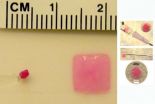(Press-News.org) Older North American farmers work fewer hours than their younger peers but spend more time operating heavy machinery and equipment—raising their risk of serious injury, according to new research from the University of Alberta.
A survey of 2,751 Saskatchewan farmers showed that as farmers age they turn to less physically strenuous work such as operating machinery. Farmers aged 45 to 64 years spent six to eight more days a year operating tractors and combines than farmers 20 years their junior—a situation that puts older farmers at risk, say the study authors.
"It's important for farmers, especially those from farm families where the older 60-plus crowd is still working, to understand that operating machinery is still a high-risk activity," said lead author Don Voaklander, a professor in the School of Public Health and director of the Alberta Centre for Injury Control and Research.
The study, published in the November issue of the American Journal of Industrial Medicine, found that farmers aged 45 to 54 spent a median of 67 days a year operating tractors and combines—the most among any age group—followed by farmers aged 55 to 64, who spent 65 days operating machinery.
In comparison, farmers aged 25 to 34 spent just 61 days on machinery.
Farming a greying industry
The farming industry is greying faster than any other occupation in North America, with an average age of 55 years—and that's only going to rise, Voaklander says.
The study included input from 519 seniors, with farmers between 65 to 74 years old working a median of 46 hours a week on the farm—just one hour less than farmers 40 years their junior. Farmers aged 75 and older worked 34 hours.
Floyd Anderson has had his share of close calls on a farming and ranching career that spans six decades. Now 73, he continues to put in 12-hour days, partly because he loves the work and partly to help his family.
"I've had too many close scrapes, actually," says Anderson, who runs a 300-head purebred cattle operation near Cardston, Alta. One of those close calls was getting his arm caught in the main drive of a combine.
"That dang near took my arm off," he says of the incident, which could have been far worse than a cut arm had the heat of the machine not cauterized the wound. "The smoking belt cauterized the artery that was cut and I made it to town."
Voaklander notes most farm fatalities are caused by working on tractors and mowing machines or working with animals, and that older farmers in particular are at high risk.
"They tend to work alone, they tend to work on older equipment and they often gravitate toward machinery jobs because it's easier to handle."
Voaklander says newer machinery has better platforms, deadman switches and safety guards that reduce injury risk. He recommends staying in contact with family as much as possible, and says family members should also heed warning signs of declining sensory capabilities such as dented or scraped machinery, or damaged fence posts.
###
The study was funded by the Canadian Institutes of Health Research and the Canadian Centre for Health and Safety In Agriculture.
Farm injury risks increase with age
2012-11-14
ELSE PRESS RELEASES FROM THIS DATE:
Study demonstrates that earlier end of life care discussions are linked to less aggressive care in final days of life
2012-11-14
In this News Digest:
Summary of a study being published online November 13, 2012 in the Journal of Clinical Oncology, reporting that earlier discussions about end of life (EOL) care preferences are strongly associated with less aggressive care in the last days of life and increased use of hospice care for patients with advanced cancer.
EOL care discussions that took place before the last 30 days of life resulted in less frequent use of chemotherapy in the last 14 days of life and lower use of acute or ICU care in the last 30 days of life, which are both known to ...
Warming temperatures will change Greenland's face
2012-11-14
Global climate models abound. What is harder to pin down, however, is how a warmer global temperature might affect any specific region on Earth.
Dr. Marco Tedesco, associate professor of earth and atmospheric sciences at The City College of New York, and a colleague have made the global local. Using a regional climate model and the output of three global climate models, they predict how different greenhouse gas scenarios would change the face of Greenland over the next century and how this would impact sea level rise.
The resulting fine-scale model gives a high-resolution ...
Fast food menu options double; calorie counts remain high
2012-11-14
With grilled chicken, salads and oatmeal now on fast food menus, you might think fast food has become healthier. And indeed, there has been greater attention in the media and legislatively, paid to the healthfulness of fast food. But a close look at the industry has found that calorie counts have changed little, while the number of food items has doubled.
A study led by Katherine W. Bauer, assistant professor in Temple University's Department of Public Health and Center for Obesity Research and Education, found that the average calorie content of foods offered by eight ...
Study finds high exposure to food-borne toxins
2012-11-14
(SACRAMENTO, Calif.) — In a sobering study published in the journal Environmental Health, researchers at UC Davis and UCLA measured food-borne toxin exposure in children and adults by pinpointing foods with high levels of toxic compounds and determining how much of these foods were consumed. The researchers found that family members in the study, and preschool children in particular, are at high risk for exposure to arsenic, dieldrin, DDE (a DDT metabolite), dioxins and acrylamide. These compounds have been linked to cancer, developmental disabilities, birth defects and ...
Fantasy-reality confusion a primary cause of childhood nighttime fears
2012-11-14
From monsters under the bed to bogeymen in the closet, most children experience nighttime fears at some point in their development. And while most grow out of them without any professional intervention, others contend with persistent and extended periods of these fears, with a risk of developing anxiety problems later in life.
As part of a large-scale project on nighttime fears funded by the Israeli Science Foundation, Prof. Avi Sadeh of Tel Aviv University's School of Psychological Sciences is exploring how these fears fit into the normal developmental process — and ...
Injectable sponge delivers drugs, cells, and structure
2012-11-14
Cambridge, Mass. – November 13, 2012 – Bioengineers at Harvard have developed a gel-based sponge that can be molded to any shape, loaded with drugs or stem cells, compressed to a fraction of its size, and delivered via injection. Once inside the body, it pops back to its original shape and gradually releases its cargo, before safely degrading.
The biocompatible technology, revealed this week in the Proceedings of the National Academy of Sciences, amounts to a prefabricated healing kit for a range of minimally invasive therapeutic applications, including regenerative medicine.
"What ...
Targeting downstream proteins in cancer-causing pathway shows promise in cell, animal model
2012-11-14
PHILADELPHIA - The cancer-causing form of the gene Myc alters the metabolism of mitochondria, the cell's powerhouse, making it dependent on the amino acid glutamine for survival. In fact, 40 percent of all "hard-to-treat" cancers have a mutation in the Myc gene.
Accordingly, depriving cells of glutamine selectively induces programmed cell death in cells overexpressing mutant Myc.
Using Myc-active neuroblastoma cancer cells, a team led by Howard Hughes Medical Institute (HHMI) investigator M. Celeste Simon, Ph.D., scientific director for the Abramson Family Cancer ...
Vitamin D may prevent clogged arteries in diabetics
2012-11-14
People with diabetes often develop clogged arteries that cause heart disease, and new research at Washington University School of Medicine in St. Louis suggests that low vitamin D levels are to blame.
In a study published Nov. 9 in the Journal of Biological Chemistry, the researchers report that blood vessels are less like to clog in people with diabetes who get adequate vitamin D. But in patients with insufficient vitamin D, immune cells bind to blood vessels near the heart, then trap cholesterol to block those blood vessels.
"About 26 million Americans now have type ...
Being neurotic, and conscientious, a good combo for health
2012-11-14
Under certain circumstances neuroticism can be good for your health, according to a University of Rochester Medical Center study showing that some self-described neurotics also tended to have the lowest levels of Interleukin 6 (IL-6), a biomarker for inflammation and chronic disease.
Researchers made the preliminary discovery while conducting research into how psychosocial factors such as personality traits influence underlying biology, to predict harmful conditions like inflammation.
Known as one of the "Big 5" traits, neuroticism is usually marked by being moody, nervous, ...
Research strengthens link between obesity and dental health in homeless children
2012-11-14
Obesity and dental cavities increase and become epidemic as children living below the poverty level age, according to nurse researchers from the Case Western Reserve University and the University of Akron.
"It's the leading cause of chronic infections in children," said Marguerite DiMarco, associate professor at the Frances Payne Bolton School of Nursing at Case Western Reserve University.
Researchers Sheau-Huey Chiu, assistant professor, and graduate assistant Jessica L. Prokp, from the University of Akron's College of Nursing, contributed to the study.
Researchers ...


